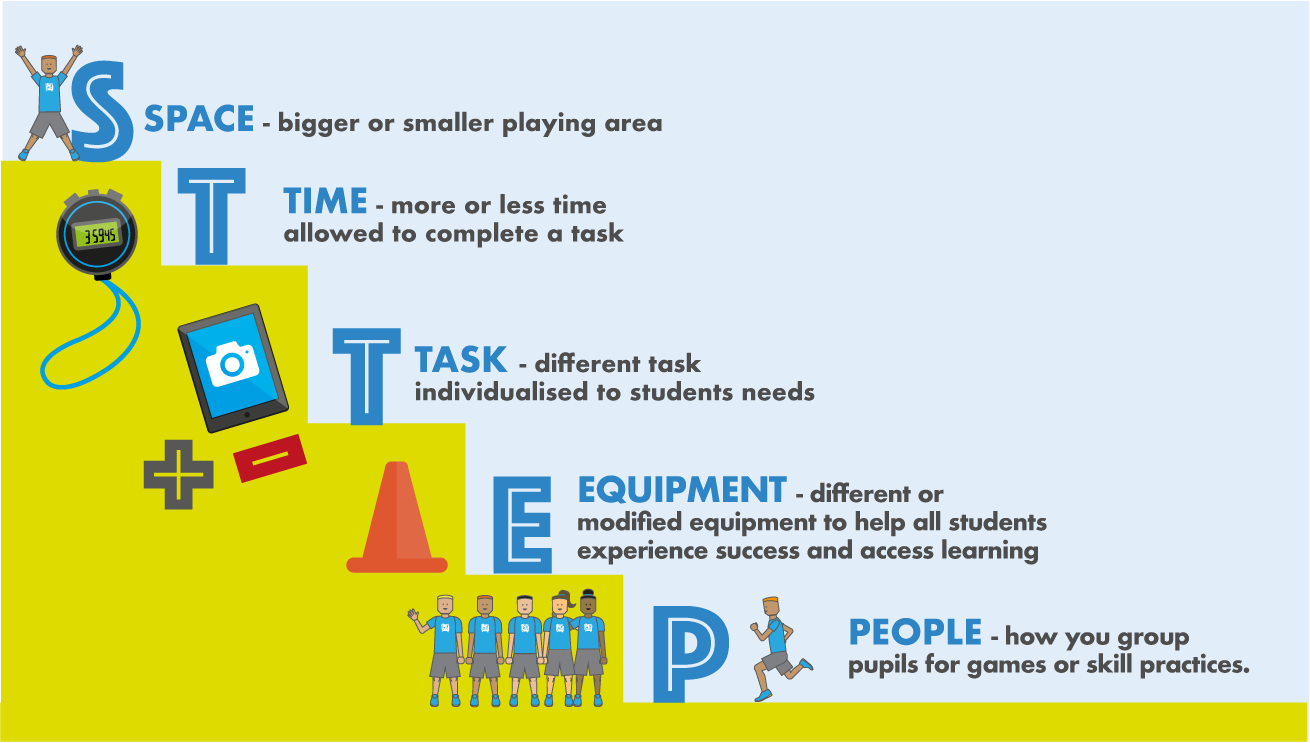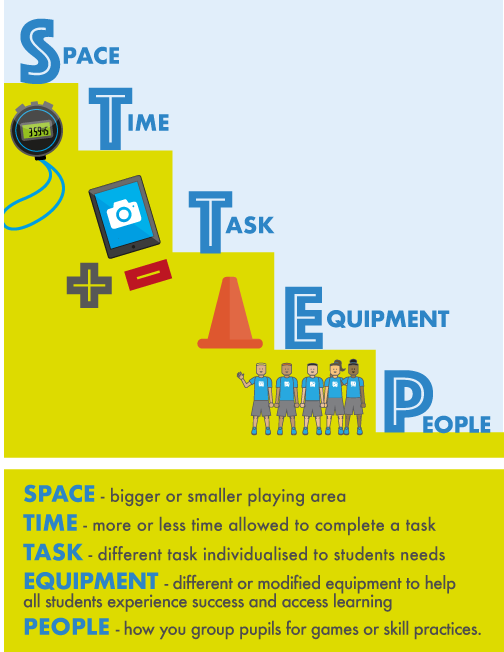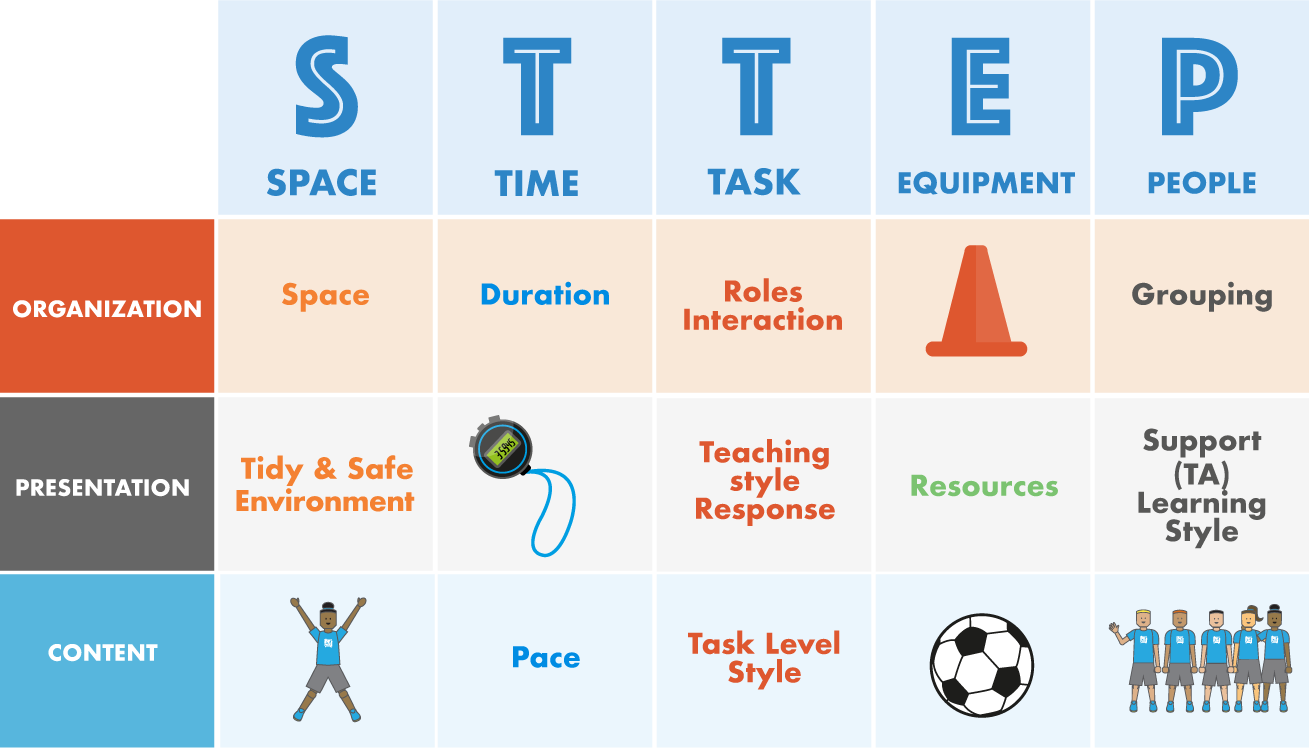
As Physical Education teachers, it is our responsibility to make sure our lessons are barrier-free and meet the diverse needs of our students – this is most commonly known as differentiation [1, 2]. It has best been described as ‘the matching of work to the differing capabilities of individuals or groups of pupils in order to extend their learning’ [3]. By planning for differentiation and integrating all pupils we ensure every student’s fundamental right to access our wonderful subject, whilst also modelling a socially inclusive society which is based upon mutual understanding and respect for individual diversity [1]. Thus, it is essential that we acknowledge students as individuals that learn in different ways and that we need to plan for differentiation by setting suitable learning challenges for all [4, 5].

To begin planning for differentiation, teachers should have an open mind, positive attitude and willingness to modify and adapt learning, teaching and assessment strategies and practices [1, 6]. Secondly, it is helpful for teachers to know the common principles of differentiation which in the PE community is known as the STTEP principle (see diagram below) [5, 7].


The STTEP principle is not the be-all and end-all of differentiation, but it useful when you need to make changes for a lesson [5]. Nevertheless, within the STTEP principle, we can find all other differentiation strategies fall under. For example, if we look in detail at ‘Task’ from the STTEP principle, we can find numerous approaches such as:

All students participate in the same activities with the teacher expecting a range of different results from students. Essentially, every activity can be considered differentiation by outcome as it doesn’t require any additional planning. Therefore, it is obvious why it has received criticism as the teacher will tend to teach to the mid-level, thus potentially neglecting two-thirds of class as the content would be either too difficult or too easy for most students [2, 5].

At its most simplest is planning different tasks (or versions of the same task) for individuals or groups within the class. This could also be considered as Differentiation by Level as students can work on tasks with varying levels of challenge [2, 5].

Is essentially assigning different positions or responsibilities to students depending upon their abilities. These could include designating leadership responsibilities (i.e., captain, coach, and referee) or even positions within a sport (i.e. Point Guard in basketball would go to the team’s best ballhandler and passer)[2].

Is utilizing different teaching approaches that best suit the student’s ability or the activity. For more independent learners, a student-centered approach would be more appropriate, whilst another group may need a more teacher-centered approach. Also, for activities where safety is paramount (e.g. javelin) a teacher-centered approach is best [2].

Is planning different activities particularly with regards to assessment. Students should be able to demonstrate their understanding in a variety of ways, such as speaking or writing, physically demonstrating a skill whether on their own or part of a group [2].

Is selecting tasks with different focuses such as competitive, co-operative or individual in accordance with student’s maturational and emotional needs. Competitive games can be high-stress situations for young people and a student with Emotional Behavioral Difficulties (EBD) may find them overwhelming if they have built enough confidence in the required skills [2].
For sake of ease, below is a table with all the varying components of the STTEP Principle and how they align with the three different strategy categories: Organization, Presentation, Content [2, 4, 7].


Most of the strategies for differentiation are self-explanatory. One important principle to consider is how students are grouped as in Differentiation by Grouping. Generally students are grouped based on their ability, with the most able students working together and the least experienced students doing the same. However, as Physical Educators we have to be careful not to judge ability based on our perceptions of student’s physical development and skill. Rather, we need to view pupil’s competencies more holistically as they may well possess advanced analytical and evaluative skills or even leadership qualities beyond their years [5]. As a result, when planning for differentiation by grouping we should utilize a range of grouping strategies such as mixed ability groups, for example, as they may have a greater potential for student progression as students can learn from each other and develop skills, attributes and values that are both inside and outside of the physical domain [2]. In order to become more competent as teaching practitioners, it is important that we invest time in both planning and trialing a wide array of differentiation strategies with our students and take note of what does and doesn’t work with certain groups and individuals. Furthermore, if you still feel inexperienced in this area, there is a wealth of literature available on this subject matter and most schools have a learning support team that would be encouraged by a visit from a PE teacher.
References
- Vickerman, P., Walsh, B. & Money, J. (2015) “Planning for an inclusive approach to learning and teaching” In, Capel, S., & Whitehead, M. (2015) Learning to Teach Physical Education in the Secondary School: A companion to school experience. Routledge: Oxon. Pp.156-170
- Bailey, R. (2001) Teaching Physical Education: A handbook for Primary and Secondary School Teachers. London: Kogan Page
- Capel, S. (1997) Learning to Teach Physical Education in the Secondary School: A Companion to School Experience. London: Routledge.
- Medcalf, R. (2012) Towards a more inclusive provision. In Griggs, G. (2012) An Introduction to Primary Physical Education. Oxon: Routledge.
- Grout, H. & Long, G. (2009) Improving Teaching & Learning in Physical Education. Berkshire: Open University Press
- Morley, D., Bailey, R., Tan., J. and Cooke B. (2005) ‘Inclusive Physical Education: teachers’ views of teaching children with special educational needs and disabilities in Physical Education’, European Physical Education Review, 11, 1: 84-87
- YST (Youth Sport Trust) (2008) High Quality Physical Education for Pupils with Autism, Loughborough: Youth Sport Trust.

